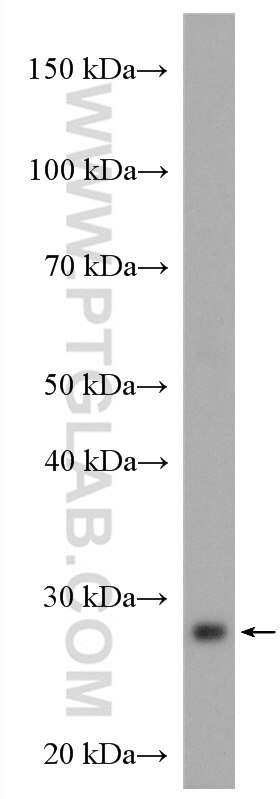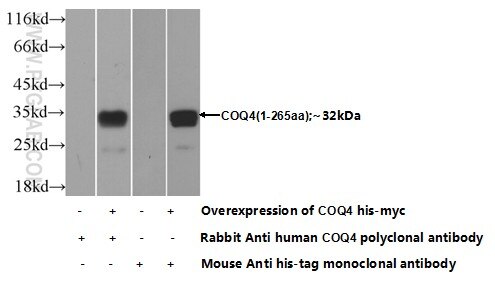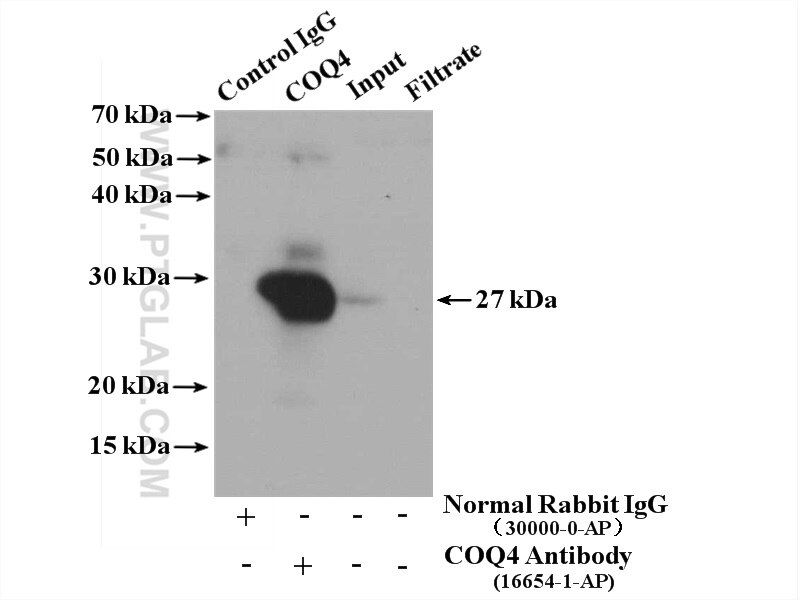- Phare
- Validé par KD/KO
Anticorps Polyclonal de lapin anti-COQ4
COQ4 Polyclonal Antibody for WB, IHC, IP, ELISA
Hôte / Isotype
Lapin / IgG
Réactivité testée
Humain, rat, souris
Applications
WB, IHC, IF, IP, ELISA
Conjugaison
Non conjugué
N° de cat : 16654-1-AP
Synonymes
Galerie de données de validation
Applications testées
| Résultats positifs en WB | tissu hépatique de souris, cellules HEK-293 transfectées |
| Résultats positifs en IP | tissu hépatique de souris, |
| Résultats positifs en IHC | tissu hépatique humain, tissu pancréatique humain il est suggéré de démasquer l'antigène avec un tampon de TE buffer pH 9.0; (*) À défaut, 'le démasquage de l'antigène peut être 'effectué avec un tampon citrate pH 6,0. |
Dilution recommandée
| Application | Dilution |
|---|---|
| Western Blot (WB) | WB : 1:500-1:2000 |
| Immunoprécipitation (IP) | IP : 0.5-4.0 ug for 1.0-3.0 mg of total protein lysate |
| Immunohistochimie (IHC) | IHC : 1:50-1:500 |
| It is recommended that this reagent should be titrated in each testing system to obtain optimal results. | |
| Sample-dependent, check data in validation data gallery | |
Applications publiées
| KD/KO | See 1 publications below |
| WB | See 9 publications below |
| IHC | See 1 publications below |
| IF | See 1 publications below |
Informations sur le produit
16654-1-AP cible COQ4 dans les applications de WB, IHC, IF, IP, ELISA et montre une réactivité avec des échantillons Humain, rat, souris
| Réactivité | Humain, rat, souris |
| Réactivité citée | Humain, souris |
| Hôte / Isotype | Lapin / IgG |
| Clonalité | Polyclonal |
| Type | Anticorps |
| Immunogène | COQ4 Protéine recombinante Ag10089 |
| Nom complet | coenzyme Q4 homolog (S. cerevisiae) |
| Masse moléculaire calculée | 265 aa, 30 kDa |
| Poids moléculaire observé | 32 kDa |
| Numéro d’acquisition GenBank | BC011895 |
| Symbole du gène | COQ4 |
| Identification du gène (NCBI) | 51117 |
| Conjugaison | Non conjugué |
| Forme | Liquide |
| Méthode de purification | Purification par affinité contre l'antigène |
| Tampon de stockage | PBS with 0.02% sodium azide and 50% glycerol |
| Conditions de stockage | Stocker à -20°C. Stable pendant un an après l'expédition. L'aliquotage n'est pas nécessaire pour le stockage à -20oC Les 20ul contiennent 0,1% de BSA. |
Informations générales
Human coenzyme Q4 (COQ4), as a component of the coenzyme Q biosynthetic pathway, is required for the oxidative decarboxylation of the C1 carbon of Coenzyme Q in eukaryotic cells (PMID: 38295803). COQ4 deficiency manifests as an early-onset neurodegenerative disorder. COQ4 encodes a ubiquitously expressed 265-amino-acid protein that is peripherally associated with the mitochondrial inner membrane on the matrix side (PMID: 25658047, 34656997)
Protocole
| Product Specific Protocols | |
|---|---|
| WB protocol for COQ4 antibody 16654-1-AP | Download protocol |
| IHC protocol for COQ4 antibody 16654-1-AP | Download protocol |
| IP protocol for COQ4 antibody 16654-1-AP | Download protocol |
| Standard Protocols | |
|---|---|
| Click here to view our Standard Protocols |
Publications
| Species | Application | Title |
|---|---|---|
Autophagy Autophagy regulates differentiation of ovarian granulosa cells through degradation of WT1 | ||
EMBO Mol Med β-RA reduces DMQ/CoQ ratio and rescues the encephalopathic phenotype in Coq9 R239X mice. | ||
Redox Biol The Q-junction and the inflammatory response are critical pathological and therapeutic factors in CoQ deficiency. | ||
Ann Clin Transl Neurol 4-Hydroxybenzoic acid restores CoQ10 biosynthesis in human COQ2 deficiency. | ||
J Med Genet Human COQ4 deficiency: delineating the clinical, metabolic and neuroimaging phenotypes. | ||
Biochim Biophys Acta Bioenerg Characterization of human mitochondrial PDSS and COQ proteins and their roles in maintaining coenzyme Q10 levels and each other's stability. |








